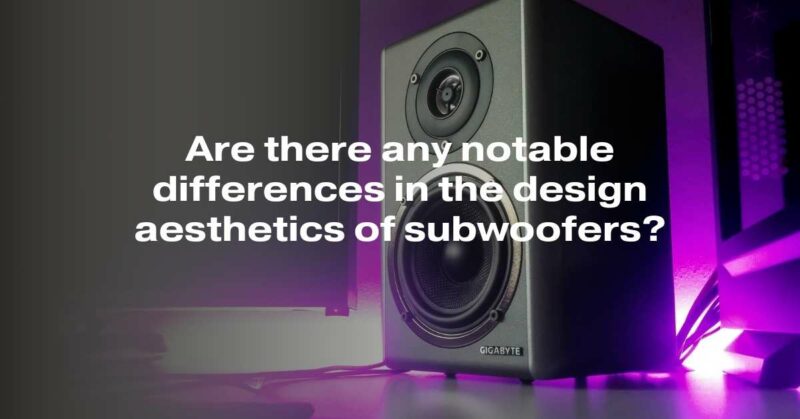Subwoofers are an essential component of any high-quality audio system, responsible for delivering deep, low-frequency sounds that can truly immerse listeners in their favorite music or movies. While the primary function of a subwoofer is to produce bass, there is much more to these devices than meets the ear. Beyond their acoustic performance, subwoofers also come in a variety of designs, each with its own unique aesthetic qualities. In this article, we will delve into the world of subwoofer design aesthetics, exploring the notable differences that set them apart.
The Role of Aesthetics in Subwoofer Design
Aesthetics play a significant role in the design of subwoofers, just as they do in other consumer electronics. Manufacturers understand that consumers not only want high-quality sound but also desire products that complement their home décor and personal style. As a result, subwoofer design aesthetics have evolved over the years to cater to diverse tastes and preferences.
- Enclosure Design
The most prominent visual aspect of a subwoofer is its enclosure or cabinet. Enclosures come in various shapes and sizes, and their design greatly influences a subwoofer’s aesthetics. Some common enclosure types include:
a. Boxed Enclosures: These are the most traditional and recognizable subwoofer enclosures. They come in square or rectangular shapes and are typically made of wood or MDF (medium-density fiberboard). Boxed enclosures can have a variety of finishes, including wood veneer, matte black, or glossy piano black. The choice of finish can significantly impact the subwoofer’s overall aesthetic.
b. Cylinder Enclosures: Cylinder-shaped subwoofers, sometimes referred to as “subwoofer tubes,” offer a unique and space-saving design. They are often covered in fabric or a textured material to blend in with home décor. Their cylindrical shape sets them apart from traditional boxy designs.
c. Low-Profile Enclosures: These subwoofers are designed to be as compact and inconspicuous as possible. They are often intended to be placed under furniture or hidden away in a room. Their aesthetics focus on being minimalistic and unobtrusive.
- Material and Finish
The choice of materials and finishes also plays a significant role in subwoofer aesthetics. Manufacturers may use materials like wood veneer, brushed aluminum, or high-gloss polymers to create a premium look and feel. The finish can range from matte to glossy, and even textured or patterned, allowing consumers to match their subwoofer to their existing furniture or audio equipment.
- Grille Design
Many subwoofers come with removable grilles that cover the speaker and protect it from damage. These grilles can be plain, fabric-covered, or feature intricate designs. Some subwoofers are designed to be used without grilles, exposing the speaker cone and providing a more industrial or high-tech appearance.
- LED Lighting and Display
For those seeking a modern and visually striking subwoofer, LED lighting and displays have become increasingly popular. Some subwoofers feature LED accent lighting that can be customized to match room decor or even sync with music. Others include digital displays that show important information like volume, input source, or EQ settings.
- Branding and Logo Placement
Manufacturers often take great care in designing their logos and branding elements to be visually appealing. The placement of these logos can vary from subtle to prominent, and the choice of fonts, colors, and materials can contribute to the overall aesthetics of the subwoofer.
Conclusion
In the world of subwoofers, aesthetics are more than just skin deep. The design of a subwoofer’s enclosure, choice of materials, finish, grille design, LED lighting, and branding all contribute to its overall visual appeal. These aesthetic elements are as diverse as the subwoofer market itself, catering to a wide range of consumer preferences.
Ultimately, the choice of a subwoofer’s design aesthetics is a personal one. Some may prefer the classic elegance of a wooden boxed enclosure, while others may gravitate towards the sleek, modern look of a high-gloss, LED-lit subwoofer. Regardless of personal taste, it’s important to remember that while aesthetics can enhance the visual appeal of a subwoofer, the most critical factor remains its acoustic performance in delivering deep, powerful bass that enriches the audio experience.


